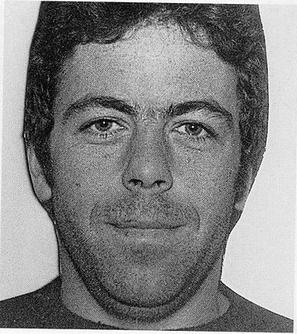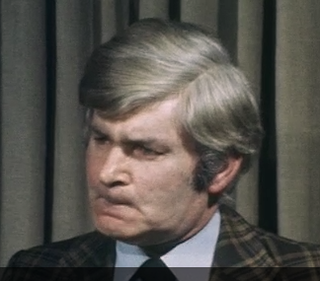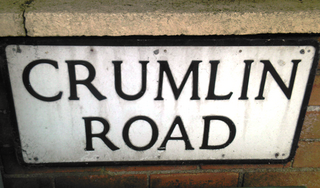The Shankill Butchers were an Ulster loyalist paramilitary gang — many of whom were members of the Ulster Volunteer Force (UVF) — that was active between 1975 and 1982 in Belfast, Northern Ireland. It was based in the Shankill area and was responsible for the deaths of at least 23 people, most of whom were killed in sectarian attacks.
A loyalist feud refers to any of the sporadic feuds which have erupted almost routinely between Northern Ireland's various loyalist paramilitary groups during and after the ethno-political conflict known as the Troubles broke out in 1969. The feuds have frequently involved problems between and within the Ulster Defence Association (UDA) and the Ulster Volunteer Force (UVF) as well as, later, the Loyalist Volunteer Force (LVF).

The Shankill Road is one of the main roads leading through West Belfast, in Northern Ireland. It runs through the working-class, predominantly loyalist, area known as the Shankill.

Hugh Leonard Thompson Murphy was a Northern Irish loyalist and UVF officer. As leader of the Shankill Butchers gang, Murphy was responsible for the murders of mainly Catholic civilians, often first kidnapping and torturing his victims. Due to a lack of evidence, Murphy was never brought to trial for these killings, for which some of his followers had already received long sentences in 1979. In the summer of 1982, Murphy was released just over half-way through a 12-year sentence for other offences. He returned to the Shankill Road, where he embarked on a murder spree.

Augustus Andrew Spence was a leader of the paramilitary Ulster Volunteer Force (UVF) and a leading loyalist politician in Northern Ireland. One of the first UVF members to be convicted of murder, Spence was a senior figure in the organisation for over a decade.

Hugh Smyth OBE was a Northern Irish politician who was leader of the Progressive Unionist Party. He was a former Lord Mayor of Belfast, as well as the longest-serving member of Belfast City Council, having first represented the Upper Shankill Road area in 1973. Smyth was awarded the Order of the British Empire in the 1996 New Year's Honours list.

John Gregg was a senior member of the UDA/UFF loyalist paramilitary organisation in Northern Ireland. In 1984, Gregg seriously wounded Sinn Féin president Gerry Adams in an assassination attempt. From the 1990s until he was shot dead in 2003 by rival associates, Gregg served as brigadier of the UDA's South East Antrim Brigade. Widely known as a man with a fearsome reputation, Gregg was considered a "hawk" in some loyalist circles.

John Dunlop McKeague was a Northern Irish loyalist and one of the founding members of the paramilitary group the Red Hand Commando in 1970. Authors on the Troubles in Northern Ireland have accused McKeague of involvement in the Kincora Boys' Home scandal but he was never convicted. He was shot dead by the Irish National Liberation Army (INLA) in Belfast in January 1982.

John "Jackie" McDonald is a Northern Irish loyalist and the incumbent Ulster Defence Association (UDA) brigadier for South Belfast, having been promoted to the rank by former UDA commander Andy Tyrie in 1988, following John McMichael's killing by the Provisional IRA in December 1987. He is also a member of the organisation's Inner Council and the spokesman for the Ulster Political Research Group (UPRG), the UDA's political advisory body.
This is a timeline of actions by the Ulster Volunteer Force (UVF), an Ulster loyalist paramilitary group since 1966. It includes actions carried out by the Red Hand Commando (RHC), a group integrated into the UVF shortly after their formation in 1972. It also includes attacks claimed by the Protestant Action Force (PAF), a covername used by the UVF. Most of these actions took place during the conflict known as "the Troubles" in Northern Ireland.

William "Frenchie" Marchant was a Northern Irish loyalist and a high-ranking volunteer in the Ulster Volunteer Force (UVF). He was on a Garda list of suspects in the 1974 Dublin car bombings, and was allegedly the leader of the Belfast UVF unit known as "Freddie and the Dreamers" which hijacked and stole the three cars which were used in the bombings.

John Dowey Bingham was a prominent Northern Irish loyalist who led "D Company" (Ballysillan), 1st Battalion, Ulster Volunteer Force (UVF). He was shot dead by the Provisional IRA after they had broken into his home. Bingham was one of a number of prominent UVF members to be assassinated during the 1980s, the others being Lenny Murphy, William Marchant, Robert Seymour and Jackie Irvine.

The Crumlin Road is a main road in north-west Belfast, Northern Ireland. The road runs from north of Belfast City Centre for about four miles to the outskirts of the city. It also forms part of the longer A52 road which leads out of Belfast to the town of Crumlin. The lower section of the road houses a number of historic buildings, including the city's former law courts and prison, whilst the road encompasses several large housing areas, including Ardoyne, Ballysillan and Ligoniel(from Irish: Lag an Aoil, meaning hollow of the lime)..

Ernest "Ernie" Elliott, nicknamed "Duke", was a Northern Irish loyalist activist and a leading member of the Ulster Defence Association (UDA) during its early days. Unusually for the generally right-wing UDA, Elliott expressed admiration for socialism and communism, and frequently quoted the words of Che Guevara and Karl Marx. Elliott was eventually killed by a fellow UDA member following a drunken brawl, although his death was variously blamed on republicans and a rival faction within the UDA.

The Springfield Road is a residential area and road traffic thoroughfare adjacent to the Falls Road in west Belfast. The local population is predominantly Irish nationalist and republican. Parts of the road form an interface area with the neighbouring Ulster loyalist areas of the Greater Shankill and it was the site of much activity during the Troubles. The Springfield Road includes the Ballymurphy and New Barnsley districts and is overlooked by Black Mountain and Divis.

James Trevor King, also known as "Kingso", was a British Ulster loyalist and a senior member of the Ulster Volunteer Force (UVF). He was commander of the UVF's "B" Company, 1st Belfast Battalion, holding the rank of lieutenant colonel. On 16 June 1994, he was one of three UVF men gunned down by the Irish National Liberation Army as he stood on the corner of Spier's Place and the Shankill Road in West Belfast, close to the UVF headquarters. His companion Colin Craig was killed on the spot, and David Hamilton, who was seriously wounded, died the next day in hospital. King was also badly injured; he lived for three weeks on a life-support machine before making the decision himself to turn it off.
Harry Stockman, also known as "Harmless" is a Northern Irish loyalist and a senior member of the Ulster Volunteer Force (UVF) paramilitary organisation. He serves as the commander of the UVF 1st Battalion Shankill Road and is allegedly the second-in-command on the UVF Brigade Staff. His uncle was Robert "Basher" Bates, a member of the notorious Shankill Butchers gang.

Jackie Coulter was a member of a loyalist paramilitary from Belfast, Northern Ireland who held the rank of lieutenant in the Ulster Defence Association (UDA). He was killed by the rival loyalist paramilitary organisation the Ulster Volunteer Force (UVF), as the result of a feud within loyalism.
The Orange Volunteers (OV) was a loyalist vigilante group with a paramilitary structure active in Northern Ireland during the early 1970s. It took its name from the Orange Order, from which it drew the bulk of its membership.
Martin "Rook" O'Prey was an Irish republican and a Volunteer in both Irish republican and Revolutionary socialist paramilitary groups, first the Irish National Liberation Army (INLA) and later the Irish People's Liberation Organisation (IPLO). He was killed by Ulster Loyalist paramilitaries from the Ulster Volunteer Force (UVF) in August 1991.














